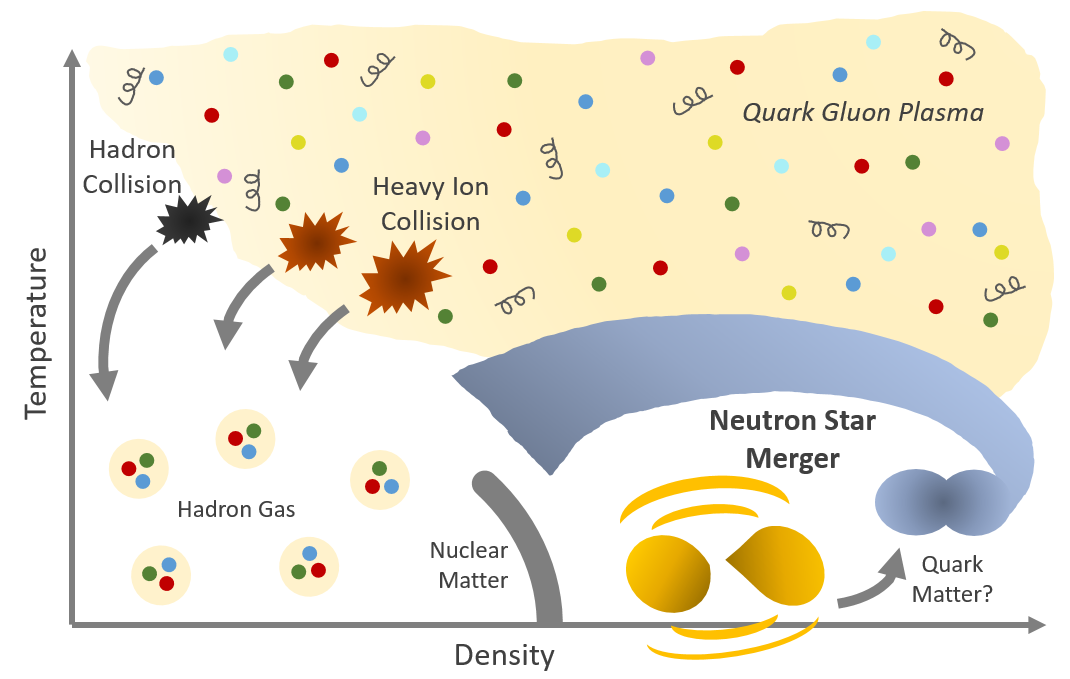Alexander HABER
|  |
Research Interests
Dense Matter in Neutron Stars
My main research interest lies in the microscopic physics that describes the matter we expect to find in compact stars and how to relate these calculations to observations. Neutron stars, as compact stars are more commonly called, are the collapsed cores of large stars, born in a supernova explosion. Neutron stars are the densest objects known to mankind after black holes, where matter is crushed beyond the limits of a description within the standard model. Therefore they present a unique laboratory for the investigation of fundamental matter, at densities and temperatures unparalleled on earth (or anywhere else in the universe). Compact stars have typical radii of R ≈ 12 km and masses between one and a few solar masses, making them as dense as the nuclei of heavy elements. Although this might not sound impressive at first sight, one has to consider that the matter we are made of is mostly empty considering the mass distribution. A sugar cube of neutron star matter has approximately the same mass as the estimated total mass of the entire human population on earth. That's the mass of Mount Everest cramped into a volume of one cubic centimeter.
Neutron Star Merger

Fig: The QCD phase diagram, i.e. the phase diagram of everything in the density-temperature plane. Neutron stars and their mergers explore a wide range of densities and parameters in the QCD phase diagram inaccessible to other experimental or theoretical approaches. Image created by Michaela Schwaiger-Haber.
When two neutron stars get created in the same system, they orbit each other for a long time. Albert Einstein taught us that such a system emits gravitational waves. But this means that the system radiates energy away from its orbit. Over time, the stars come closer and closer to each other until they merge in a violent event we call a binary neutron star merger. Due to the recent discovery of gravitational waves from such binary neutron star mergers by the LIGO and VIRGO observatories, a new way to examine the underlying physics of these stellar objects has emerged. To extract these faint signals from the noise, detailed simulations using numerical relativity and relativistic hydrodynamics have to be performed in advance. These simulations are highly complex and can only account for a limited amount of underlying microphysical processes. Therefore, it is necessary to provide improved estimates of which microscopic transport phenomena and dissipation mechanisms are important on a neutron star merger time scale, which is approximately 20 ms post-collision. In 2017, my post-doctoral advisor Mark Alford and collaborators computed the first estimates of time scales for various nuclear transport and dissipation processes and showed that nuclear bulk viscosity can potentially play an important role in neutron star mergers. Bulk viscosity is the energy lost to heat when matter gets periodically compressed and decompressed. Many calculations of the past in this research area have mostly dealt with old and cold neutron stars. However, the environment in a neutron star merger is far more extreme. We try to improve on these calculations not only in "ordinary" nuclear matter, but also compute it for the more exotic kinds of matter like hyperons.
Superfluidity and (Color-) Superconductivity
There are many interesting microphysical phenomena taking place in these stars that might influence what we can observe on earth. One of them is superfluidity and superconductivity. Whereas most people think of these effects as low-temperature phenomena (helium on earth only becomes superfluid at temperatures lower than -270 centigrades), the immense pressure in neutron stars most likely leads to superfluidity of neutrons and superconducting protons. This is a complicated, multicomponent system that can lead to different kinds of fascinating observable effects, like pulsar glitches. Together with my Ph.D. supervisor Andreas Schmitt I have investigated these systems not only in nuclear but also in quark matter. For the relevant publications see my publications page or download my Ph.D. thesis from the arXiv .